Abstract
A 58-year-old man was referred to our hospital because of chest pain. The 12-lead electrocardiogram (ECG) revealed ST-segment elevation in II, III, and a Vf with advanced heart block. Transthoracic echocardiography demonstrated aortic root dilatation at the sinus of Valsalva, moderate aortic regurgitation, and decreased wall motion in the inferior part of the left ventricle. Non-ECG-gated enhanced computed tomography (CT) did not reveal an aortic dissection. The patient underwent emergent coronary angiography, which revealed a severely narrowed ostium of the right coronary artery (RCA). Percutaneous coronary intervention (PCI) was performed under intravascular ultrasound (IVUS) guidance. IVUS images demonstrated an intimal flap extending from the aortic wall to the proximal RCA, suggesting that a periaortic hematoma in the false lumen compressed the ostium of the RCA, leading to acute myocardial infarction. To recover hemodynamic stability, the RCA ostium was stented. Subsequent ECG-gated enhanced CT clearly depicted the entry point and extension of the dissection localized within the sinus of Valsalva. The dissection likely involved the left main coronary artery and an emergent Bentall procedure was performed. Intraoperative findings confirmed an intimal tear and extension of the dissection. Thus, ECG-gated CT can clearly depict the entry site and extension of a dissection occurring in the localized area that cannot be detected by conventional CT.




Similar content being viewed by others
References
Okina N, Ohuchida M, Takeuchi T, Fujiyama T, Satoh A, Sakamoto T, Adachi H, Imaizumi T (2013) Utility of measuring C-reactive protein for prediction of in-hospital events in patients with acute aortic dissection. Heart Vessels 28(3):330–335
Hansen MS, Nogareda GJ, Hutchison SJ (2007) Frequency of and inappropriate treatment of misdiagnosis of acute aortic dissection. Am J Cardiol 99(6):852–856
Yoshida S, Akiba H, Tamakawa M, Yama N, Hareyama M, Morishita K, Abe T (2003) Thoracic involvement of type A aortic dissection and intramural hematoma: diagnostic accuracy–comparison of emergency helical CT and surgical findings. Radiology 228(2):430–435
Mano Y, Anzai T, Yoshizawa A, Itabashi Y, Ohki T (2015) Role of non-electrocardiogram-gated contrast-enhanced computed tomography in the diagnosis of acute coronary syndrome. Heart Vessels 30(1):1–8
Svensson LG, Labib SB, Eisenhauer AC, Butterly JR (1999) Intimal tear without hematoma: an important variant of aortic dissection that can elude current imaging techniques. Circulation 99(10):1331–1336
Roos JE, Willmann JK, Weishaupt D, Lachat M, Marincek B, Hilfiker PR (2002) Thoracic aorta: motion artifact reduction with retrospective and prospective electrocardiography-assisted multi-detector row CT. Radiology 222(1):271–277
Author information
Authors and Affiliations
Corresponding author
Ethics declarations
Conflict of interest
The authors declare that they have no conflicts of interest.
Rights and permissions
About this article
Cite this article
Ichihashi, T., Ito, T., Murai, S. et al. Acute myocardial infarction due to spontaneous, localized, acute dissection of the sinus of Valsalva detected by intravascular ultrasound and electrocardiogram-gated computed tomography. Heart Vessels 31, 1570–1573 (2016). https://doi.org/10.1007/s00380-015-0787-5
Received:
Accepted:
Published:
Issue Date:
DOI: https://doi.org/10.1007/s00380-015-0787-5




